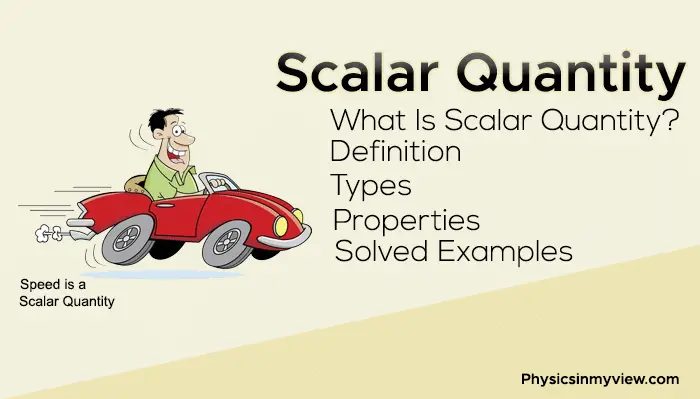Everything in this world requires measurement. Measuring your weight to maintain a healthy lifestyle, measuring the petrol tank to remember how much fuel is left until the next refill, or measuring of time it takes you to reach your workplace from your loft.
But the means of measurements are different. Weight in Kilograms, Petrol in Litres, and Time in Minutes/Hours along with the Distance in Kilometres. And some of these measurements are different at their core.
What is a Scalar Quantity?
Unlike Vector quantities, for example, force, Scalar Quantity is dependent on only magnitudes. No directions are required or needed.
There are plenty of examples for scalar quantities that you may have or do across in your life, such as mass, temperature, density, time, area, distance, speed, etc.
To prove that scalar quantity does not require direction, let us take temperature as a case study. Do you consider the direction of it when checking the temperature of a cold storage room, refrigerator, fever, or oven? No. Hence proved.
Editor’s Choice: Difference Between Scalar and Vector Quantity (All New)
Definition
A quantity with only magnitude and no direction. When such a quantity is part of arithmetic operations like addition, subtraction, multiplication, or division, the magnitude value or, more precisely, the numerical value is taken.
Types
There are numerous types and examples, and each quantity has a different set of units. Those units are again of the mks and cgs system and are represented quite differently. There is no particular broad classification of Scalar Quantities.
Let us look at some examples.
| Scalar Quantity / Unit System with Symbols | CGS System | MKS System |
| Mass (m) | g | kg |
| Speed (v) | cm/s | m/s |
| Density (⍴) | K | K |
| Temperature (T) | sec | sec |
Properties
Property 1: The magnitude values of the scalar quantity are absolute – |a| |b| = ab.
Property 2: Scalar quantity adheres to the associative property – a(bc) = (ab)c.
Property 3: Scalar quantity follows the rule of commutative property – ab = ba.
Property 4: Distributive property is also part of the Scalar quantity – a(b + c) = ab + ac.
Property 5: The unity rule of identity property is seen in Scalar Quantity – 1a = a.
Property 6:
⦁ If a Scalar quantity is with a negative sign, then according to the multiplicative property, the sign also multiplies with the term – (-1)a = -a.
⦁ If a Scalar quantity is multiplied with ‘0’, the term also nullifies in abidance to the multiplicative property – (0)a = 0b.
Solved Examples
Example 1: George walks to school every day. The distance between his school and home is 500m. He takes a bus from the bus stand, which is 150m from his school, on the way back home. What is the distance between his home and the bus stand?
Solution 1:
Given:
Total distance from home to school, DT = 500m
Distance between bus stand and school, D1 = 150m
To Find Out:
Distance between home and bus stand, D2 =?
In words,
To calculate the distance between home and the bus stand, you will need to subtract the total distance from home to school from the distance between the bus stand and school.
In figures
D2 = DT – D1
= 500 – 150
= 350m.
So, the distance between George’s home and the bus stand is 350m. No direction is required to calculate the answer; hence Distance is a Scalar Quantity.
Editor’s Choice: Dot Product vs Cross Product (Tabular Form)
Example 2: You have three gold chains, and you want to sell all of them. Each of them weighs differently, and the numbers are 27.50gm, 43.42gm, and 12.23gm, respectively. What will be the total quantity of all three chains?
Solution 2:
Given:
Weight of the first gold chain, W1 = 27.50gm
Weight of the second gold chain, W2 = 43.42gm
Weight of the third gold chain, W3 = 12.23gm
To Find Out:
Total Weight of all three gold chains, WT =?
In words,
To calculate the total weight of all three gold chains, add the quantities of all three.
In figures
WT = W1 + W2 + W3
= 27.50 + 43.42 + 12.23
= 83.15gm.
So, the total weight of all three gold chains is 83.15gm.No direction is required to calculate the answer; hence, Mass is a Scalar Quantity.
Conclusion
What is a Scalar quantity is comparable to What is a Vector Quantity; however you cannot replace them as direction is the factor that adds to the equation. And direction changes the solution to a problem vastly.
That’s it for this post. If you like this article, share it if you like, like it if you share it. You can also find us on Mix, Twitter, Pinterest, and Facebook. Hey man, If you have come this far, do give us feedback in the comment section. It would make my day. You can also make a donation. Your donations will help us to run our website and serve you BETTER. Cheers!!!
You might also like:
- Vector Quantity – Definition, Types, Properties, Solved Examples
- Dot Product – Definition, Types, Properties, and Solved Examples
- Cross Product – Definition, Cross Product For Two Vectors, Right Hand Rule, Properties and solved examples
